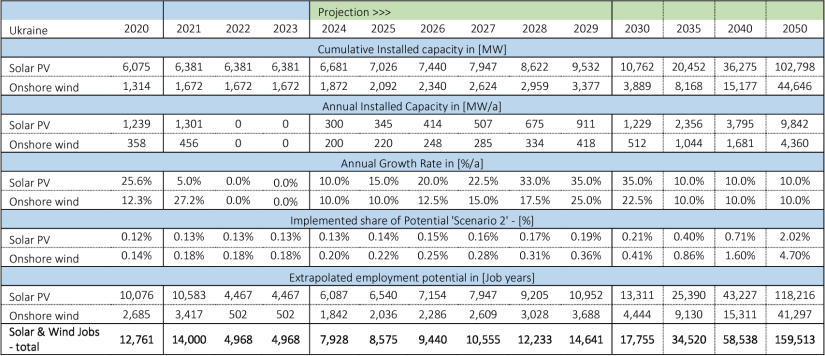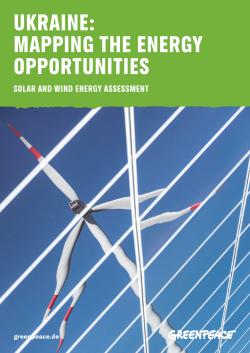Greenpeace Germany has commissioned the Institute for Sustainable Futures (ISF) at the University of Technology Sydney (UTS) to analyse the solar and wind potential of Ukraine based on digital Geographic information system (GIS) maps.
The primary purpose of GIS mapping is to ascertain the solar and wind energy resources available. It also contributes to the regional analysis of geographic and demographic parameters and the available infrastructure that can be leveraged in developing the scenarios. The comprehensive data set of the solar and wind energy potential for Ukraine is aimed to support a ‘Green Rebuild’ concept. The GIS data of this analysis in a 250m-by-250m resolution is available to all government institutions of Ukraine.
Ukraine has significant solar power resources – detailed solar and wind potential assessment conducted by ISF
1% of the suitable land for solar and wind can supply Ukraine’s entire electricity demand
Ukraine has an enormous solar and wind energy potential that exceeds current electricity demand (125 TWh/a)– even under conservative land-use restriction – close to 150 times over. Thus, only a small percentage of the theoretical suitable land for utility solar and onshore wind is required to supply the entire country with electricity.
Even under the assumption, that a future full decarbonisation of Ukraine’s energy supply will triple or even quadruple due to increased electrification of the transport sector, residential space heating with heat pumps and industrial process heating via synthetic fuels such as hydrogen and ammonia as well as industrial scale heat pumps, the renewable electricity potential does not provide any limitations. Furthermore, besides solar and onshore wind, Ukraine can utilise offshore wind, bio energy, geothermal energy and hydro power. However, the potential analysis for those sources were out of scope for this research.
The energy economic importance of Ukraine solar and onshore wind electricity generation potential becomes clear when compared to its domestic electricity demand. Under the assumptions of scenario 1, only 0.46% of the solar and 0.4% of the wind potential, would be sufficient to supply the entire country with electricity. Under the more realistic assumption to utilise only land within a proximity of 10 km from a high voltage line, Ukraine could generate its final electricity demand (2021) with only 1% of its suitable land area for solar and wind installations.
Ukraine – solar and wind potential in comparison to domestic demand
Ukraine can export renewable electricity to the EU
Ukraine’s significant solar and onshore wind resources cannot only be utilised for domestic supply, but also for energy exports to the neighbouring countries. The energy can be exported either in form of electricity via power grid, or in form of hydrogen, synthetic fuels – produced with renewable electricity – via pipeline or tanker over land or sea.
To put Ukraine’s solar and onshore wind potential into a European perspective, the results are compared with renewable energy potentials for the EU27 and selected European countries which served as a basis for 1.5˚C Paris aligned decarbonization pathways, a research project for the United Nations Finance Initiative and the UN-convened Net Zero Asset Owners Alliance undertaken in 2023. The table below shows the solar and onshore wind potential, both in regard of the installed capacity in Gigawatt [GW] as well as the expected average annual generation in Terawatt hours per year [TWh/a]
Ukraine – solar and wind potential in comparison to the European Union (EU27) and selected member countries
Renewable energy can create close to 20,000 new jobs for Ukraine by 2030
Finally, renewable energies provide long-term job opportunities. According to the International Renewable Energy Agency (IRENA), the renewable energy industry provides 13.7 million globally in 2023, 1 million more than in 2022. About 4.9 million jobs were in the solar photovoltaic industry, followed by around 2.5 million jobs both in the hydro power and biofuels industry and 1.4 million jobs in the wind industry.
To estimate the approximate job potential, a very simple market development scenario for the Ukrainian solar and wind industry was adopted: It was assumed that by 2030 the market for new installed solar and wind systems would be back to the level of 2021 and then increase continuously over the next 20 years with robust annual market growth. The table below shows the simplified employment potential estimation and the assumed solar and wind market development. The red values are inputs and rough estimation. This calculation is strictly indicative, and a more detailed energy scenario development and industry assessment is required.
Green Rebuild – Solar and Wind development scenario
Conclusion
Ukraine can not only generate its entire domestic electricity demand with solar photovoltaic and onshore wind power plants on only 1 percent of the suitable land. Furthermore, Ukraine has a significant export potential for renewable electricity in countries of the European Union. To utilise this significant economic potential, existing power lines need to be strengthened and new power lines must be built to connect Ukraine closer to the EU.
Renewable energy can provide new income for Ukraine economy and could create new jobs and long-term employment opportunities.
Download the report
Ukraine: Mapping the energy opportunities - Solar and Wind Energy Assessment (2024) (Report)
The report is also available in Ukrainian
Researchers: Sven Teske and Saori Miyake




